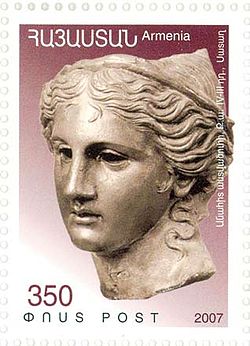GODDESS ANAHIT!
We may meet, Goddess Anahit! You gave me your name and your ancient myth. There's a bench where I can sit. There's a branch where a bird can sing. I wonder if you gave me your perfume made from mint. Do the stars stretch their knees not to slip? You didn't smoke but I do, Goddess Anahit! However the ashes are the same in time's messages. Who knows whose beauty shone in the ancient fortresses? You are still a statue in time's voyages. Who am I in my old and new bandages? We have the same name in time's images. Do the stars meet their myth Goddesses?


The label for the head of a gilded statue in a glass box in the British Museum in London reads, “Bronze head of a goddess, probably Aphrodite.” Stutuary fragments were found in 1872 by a farmer digging in Satagh (Satala) in southeastern Turkey, near the site of an ancient Roman camp. The head went to Istanbul and then to Alessandro Castellani, who sold it to the British Museum. The statue’s hand was given to the museum years later. Despite the label, many Armenians believe that its real identity is Anahit, the ancient goddess of fertility, healing, wisdom, and water, and a modern symbol of their nation. The bust is featured on banknotes, stamps, and coins and is better known to Armenians than the country’s official state emblem. Originally a war goddess, she probably evolved from the Avestan Anahita (Aredvi Sura Anahita) via the Persian goddess, Anahita, but, unlike the Persians, Armenians incorporated idol-worship into her cult. By the 5th century BCE she was part of their divine triad. Artaxias I (ca. 190-160 BCE), who established the first independent Armenian kingdom, erected statues of Anahit and promulgated orders to worship them. Anahit-worship was established in Armavir, Artashat, Ashtishat, and especially Ereza (Erez) [later renamed Anaïtica] in Akilisene (Ekeghiats); in fact, the entire district of Erez was called Anahtakan Gavar, and the temple there was the wealthiest and most venerable in Armenia, staffed with priests and with priestesses from eminent families who served there before marrying. Marcus Antonius’ soldiers soldiers smashed an enormous golden statue of Anahita there and then divided the pieces among themselves. According to Strabo, in the 1st century, her worship included rituals of sacred prostitution (though there is no other testimory or corroborative evidence for this claim). A mountain in the Sophene district was known as “Anahit's throne” (Athor Anahta). As late as the 3rd century, Trdat III the Great extolled her as “the glory of our nation and vivifier, mother of all chastity, benefactress of the whole human race, mother of all knowledge.” When he was two, the Parthian king Ardashir I had his mother murdered; the assassin was executed along with his family, but his son Grigor was sheltered in Caesaria in Cappadocia, and raised there as a Christian; returning to Armenia, he joined the army and became Trdat’s secretary. During a religious ceremony, Trdat ordered Grigor to place a flower wreath at the foot of the golden statue of the goddess Anahit in Erez, but Grigor refused and proclaimed his Christian faith. Trdat had him tortured and thrown into Khor Virap, a deep underground pit on the Ararat plain, where he was imprisoned and left for dead for 12 (or 14) years. But Trdat became mentally disturbed and began wandering in the woods, behaving like a wild boar; Grigor was taken to the king in 301 and miraculously cured him; Trdat immediately proclaimed his kingdom the first officially Christian nation and made Grigor the head of the church. For the rest of his reign he made war against the pagan cults, destroying countless statues, temples, and documents.
ReplyDelete